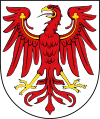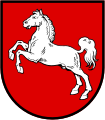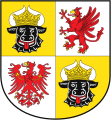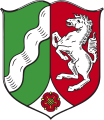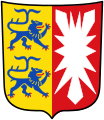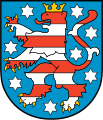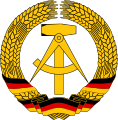This is a list of coats of arms of Germany.
YouTube Encyclopedic
-
1/5Views:15 4341 617 96011 55028 840137 100
-
Pt 1 - European Coat of Arms / Family Crest of "Black" Nobles of Europe / Germany / Wappanbuch
-
Europe's Top 10 Most Powerful Countries
-
Pt 5 - European Coat of Arms / Prussian, Dutch, Bavarian, Saxon, Austrian / American Indians Too ???
-
Heraldry & Symbols of the 12 Tribes of lsrael in Europe
-
Coats of Arms of Sovereign States - Part 1
Transcription
German Federal States
The origins of the coats of arms of German federal states covers the historical context for the current arms of the German länder.
After the end of the Third Reich, Germany had lost significant parts of its territory and was divided into four occupation zones. Several former states were split between two or more of these zones. The historical state of Prussia, which spread over more than half the territory of Germany, was officially abolished by the Allies; and several new states were formed from its former lands while other parts were annexed by Poland or the USSR.
Some of these states were direct successors of former states, although the former borders changed; others were new constructions. In some cases parts of former states were declared states; in other cases, parts of different states formed a new state. Only the historic city-states of Hamburg and Bremen survived the end of the Third Reich without significant changes of their territory.
The Federal Republic was joined by the Saarland in 1957 and by five states of the former German Democratic Republic in 1990. Each of these states adopted new arms upon joining the federation, by combining the centuries-old coats of the former states (or ruling houses) from whose territories they were formed.
Overview and historical versions of state arms
Coat of arms of Baden-Württemberg
- Coat of arms of Baden-Württemberg
- Coat of arms of Hohenstaufen
- Coat of arms of the Elector Palatine, one shield used in full arms
- Coat of arms of Wurzburg, one shield used in full arms
- Coat of arms of Baden, predecessor state of the Weimar Period and before; one shield used in full arms
- Coat of arms of Württemberg-Baden, predecessor state of the Weimar Period
- Coat of arms of Württemberg-Hohenzollern, predecessor state of the Weimar Period
- Coat of arms of the Kingdom of Württemberg, historical state
- Coat of arms of Hohenzollern, one shield used in full arms
- Preceding states (Zollern, Hohenzollern-Sigmaringen, Hohenzollern-Hechingen and the Province of Hohenzollern) until Württemberg-Hohenzollern used these arms; rulers chose variations and additions thereupon.
- Coat of arms of the Electorate of the Palatinate, one shield used in full arms
- Coat of arms of Austria (lesser), one shield used in full arms
Coat of arms of Bavaria
- Coat of arms of Bavaria
- Coat of arms of the Kingdom of Bavaria and preceding Wittelsbach dynasty
- Coat of arms of Kraiburg
- Franconian rake, one charge used in full arms
- Coat of arms of the Elector Palatine, one charge used in full arms
Coat of arms of Berlin
Coat of arms of Brandenburg
- Coat of arms of Brandenburg
- Historical arms, including the Province of Brandenburg
Coat of arms of Bremen
Coat of arms of Hamburg
Coat of arms of Hesse
Coat of arms of Lower Saxony
- Coat of arms of Lower Saxony
- Saxon Steed, principal charge and motif
- Coat of arms of the Free State of Brunswick (1918–1946), predecessor state
- Coat of arms of the Duchy of Brunswick (1815–1918) (full and lesser), predecessor state
- Coat of arms of the Duchy of Brunswick-Lüneburg (1235–1708) predecessor state
- Coat of arms of the Electorate of Brunswick-Lüneburg (Hanover), predecessor state
- Coat of arms of the Kingdom of Hanover (1814–1866), predecessor state
- Coat of arms of the Prussian Province of Hanover (1868–1946), predecessor state
- Coat of arms of the Free State of Oldenburg (1918–1946), predecessor state
- Coat of arms of Oldenburg (1180–1918), predecessor state
- Coat of arms of the Free State of Schaumburg-Lippe (1918–1946), predecessor state
- Coat of arms of Schaumburg-Lippe (1643–1918), predecessor state
- Coat of arms of Schaumburg (1110–1640), predecessor state
- Saxon Steed, principal charge and motif
Coat of arms of Mecklenburg-Vorpommern
- Coat of arms of Mecklenburg-Vorpommern
- For history, see Mecklenburg-Schwerin, Mecklenburg-Strelitz and Duchy of Pomerania, predecessor states.
Coat of arms of North Rhine-Westphalia
- Coat of arms of North Rhine-Westphalia
- For history, see also Rhine Province, Province of Westphalia and Principality of Lippe, predecessor states.
Coat of arms of Rhineland-Palatinate
- Coat of arms of Rhineland-Palatinate
- Wheel of Mainz, principal charge
- Coat of arms of the Elector Palatine, principal charge
- Coat of arms of the Archbishop of Mainz (historical)
Coat of arms of Saarland
- Coat of arms of Saarland
- Coat of arms of Nassau-Saarbrücken, predecessor state and one of the quarters of the arms
- Coat of arms of the Duchy of Lorraine, predecessor state, predecessor state and one of the quarters of the arms
- Coat of arms of the Archbishop of Trier, predecessor state, predecessor state and one of the quarters of the arms
- Coat of arms of the Elector Palatine, predecessor state, predecessor state and one of the quarters of the arms
Coat of arms of Saxony
Coat of arms of Saxony-Anhalt
- Coat of arms of Saxony-Anhalt
- Historical arms, including the Prussian province of Saxony
- Coat of arms of Anhalt, predecessor Princedom
Coat of arms of Schleswig-Holstein
- Coat of arms of Schleswig-Holstein
- Coat of arms of the Dukes of Holstein-Gottorp, predecessor dukedom
Coat of arms of Thuringia
Historical coats of arms
-
The Arms of the Holy Roman Empire
-
The Arms of the German Confederation, 1815–1866
-
Small Arms of the German Empire, 1871–1918
-
The Greater Arms of the German Empire, 1871–1918
-
The Lesser Arms of the German Empire, 1871–1918
-
Arms of the Weimar Republic, 1919–1928
-
Arms of the Weimar Republic, 1928–1935
-
National insignia (Hoheitszeichen) of Nazi Germany, 1935–1945
-
Coat of arms of the German Democratic Republic, 1950–1953
-
Coat of arms of the German Democratic Republic, 1953–1955
-
Coat of arms of the German Democratic Republic, 1955–1990
-
Coat of arms of the Federal Republic of Germany, 1950–present
Colonies
Coats of arms of German colonies were prepared but never formally granted.[1]
In 1914, the diplomat Wilhelm Solf proposed that Germany's colonies be assigned flags and arms, like the flags and arms used by the British colonies. Solf believed that these would serve to advertise Germany's power, and would encourage German pride amongst the colonials. Kaiser Wilhelm was enthusiastic about the idea, and drafts were prepared for his inspection by Solf in conjunction with the Heraldry Office and the Duke of Mecklenburg. However, World War I broke out before the project was finalised, and the arms were never actually taken into use. This was in part because giving the colonies their own insignia in times of war could have let them have symbols to rally around in rebellion.[2] Following the defeat in the war, Germany lost all its colonies and the prepared arms were therefore never granted.
The arms all followed a similar style. In chief was placed the Imperial Eagle, bearing a shield with the arms of the House of Hohenzollern. In the main part of the shield was a colony specific symbol, such as an elephant for the colony of Kamerun. Above the shield was placed the German State Crown (which was merely symbolic, and did not physically exist). Early drafts included a scroll displaying the name of the colony or protectorate in German, but given the unheraldic nature of such a name scroll, it is unlikely this would have been part of the final blazon.
 |
 |
 |
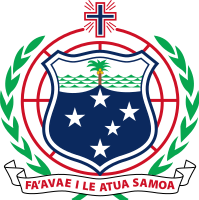 |
 |
 |
| German New Guinea (Papua New Guinea) | German Samoa (Samoa) | German South-West Africa (Namibia) | |||
 |
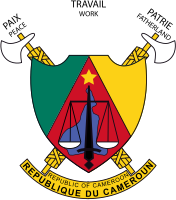 |
 |
 |
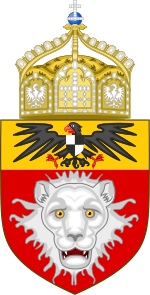 |
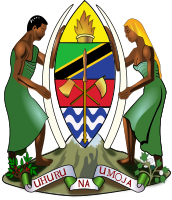 |
| Kamerun (Cameroon; parts of territory voted to join Nigeria) | Togoland (Togo; parts of territory voted to join Ghana) | German East Africa (Tanzania; parts of territory became states of Rwanda and Burundi) | |||
See also
References
- ^ The Emperor's new coat of arms (Spiegel Online, 26 February 2009, in German).
- ^ Schurdel, H.D. Battenberg (1995). Flaggen & Wappen Deutschland - Heraldik, Hymnen, BRD & DDR Flaggen und Wappen, Deutsche Ostgebiete, ehem. deutsche Kolonien u.v.m.
External links
- Kolonialflaggen
- Flag use in German colonies
- Flags of the World - Former Colonies and other Overseas Territories (Germany) (in English)




